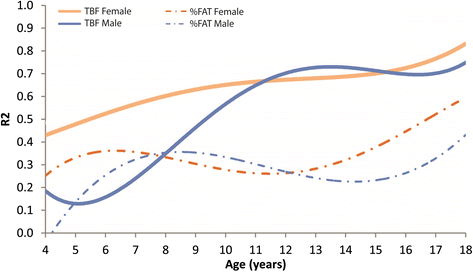BMI is a poor predictor of adiposity in young overweight and obese children
- PMID: 28577356
- PMCID: PMC5457636
- DOI: 10.1186/s12887-017-0891-z
BMI is a poor predictor of adiposity in young overweight and obese children
Abstract
Background: The body mass index (BMI) is a simple and widely utilized screening tool for obesity in children and adults. The purpose of this investigation was to evaluate if BMI could predict total fat mass (TFM) and percent body fat (%FAT) in a sample of overweight and obese children.
Methods: In this observational study, body composition was measured by dual energy x-ray absorptiometry (DXA) in 663 male and female overweight and obese children at baseline within a multidisciplinary, pediatric fitness clinic at an academic medical center. Univariate and multivariate regression analyses were conducted to evaluate whether BMI z-score (BMIz) predicts TFM or %FAT.
Results: The BMIz, sex and age of subjects were identified as significant predictors for both TFM and %FAT. In subjects younger than 9 years, the BMIz was a weak to moderate predictor for both TFM (R2 = 0.03 for males and 0.26 for females) and %FAT (R2 = 0.22 for males and 0.38 for females). For subjects between 9 and 18 years, the BMIz was a strong predictor for TFM (R2 between 0.57 and 0.73) while BMIz remained only moderately predictive for %FAT (R2 between 0.22 and 0.42).
Conclusions: These findings advance the understanding of the utility and limitations of BMI in children and adolescents. In youth (9-18y), BMIz is a strong predictor for TFM, but a weaker predictor of relative body fat (%FAT). In children younger than 9y, BMIz is only a weak to moderate predictor for both TFM and %FAT. This study cautions the use of BMIz as a predictor of %FAT in children younger than 9 years.
Keywords: Body composition; Body mass index; Childhood obesity; Dual X-Ray absorptiometry.
Figures
Similar articles
-
BMI z-score in obese children is a poor predictor of adiposity changes over time.BMC Pediatr. 2018 Jun 8;18(1):187. doi: 10.1186/s12887-018-1160-5. BMC Pediatr. 2018. PMID: 29880034 Free PMC article.
-
Cardiometabolic risk: leg fat is protective during childhood.Pediatr Diabetes. 2016 Jun;17(4):300-8. doi: 10.1111/pedi.12292. Epub 2015 Jun 17. Pediatr Diabetes. 2016. PMID: 26083149
-
Stabilization of BMIz Score is Associated with a Decrease in Visceral Fat in Children with Obesity.Horm Metab Res. 2020 Jul;52(7):527-531. doi: 10.1055/a-1159-4506. Epub 2020 Jun 2. Horm Metab Res. 2020. PMID: 32485744 Free PMC article.
-
Overview of BMI and Other Ways of Measuring and Screening for Obesity in Pediatric Patients.Pediatr Clin North Am. 2024 Oct;71(5):781-796. doi: 10.1016/j.pcl.2024.07.002. Epub 2024 Aug 1. Pediatr Clin North Am. 2024. PMID: 39343492 Review.
-
Body composition in children.Pediatr Exerc Sci. 2013 Nov;25(4):573-90. doi: 10.1123/pes.25.4.573. Pediatr Exerc Sci. 2013. PMID: 24214440 Review. No abstract available.
Cited by
-
Cardiopulmonary Capacity in Overweight and Obese Children and Adolescents: A Cross-Sectional Study.Front Physiol. 2021 May 13;12:671827. doi: 10.3389/fphys.2021.671827. eCollection 2021. Front Physiol. 2021. PMID: 34054581 Free PMC article.
-
Dietary Knowledge, Dietary Adherence, and BMI of Lebanese Adolescents and Their Parents.Nutrients. 2020 Aug 11;12(8):2398. doi: 10.3390/nu12082398. Nutrients. 2020. PMID: 32796513 Free PMC article.
-
Effect Evaluation of Sahtak bi Sahnak, a Lebanese Secondary School-Based Nutrition Intervention: A Cluster Randomised Trial.Front Nutr. 2022 Mar 16;9:824020. doi: 10.3389/fnut.2022.824020. eCollection 2022. Front Nutr. 2022. PMID: 35369051 Free PMC article.
-
A Pilot Study Examining Body Composition Classification Differences Between Body Mass Index and Bioelectrical Impedance Analysis in Children With High Levels of Physical Activity.Front Pediatr. 2021 Nov 15;9:724053. doi: 10.3389/fped.2021.724053. eCollection 2021. Front Pediatr. 2021. PMID: 34869095 Free PMC article.
-
Modification of the association by sex between the prenatal exposure to di(2-ethylhexyl) phthalate and fat percentage in a cohort of Mexicans schoolchildren.Int J Obes (Lond). 2022 Jan;46(1):121-128. doi: 10.1038/s41366-021-00952-w. Epub 2021 Sep 20. Int J Obes (Lond). 2022. PMID: 34545176
References
-
- National Center for Health Statistics . Health, United States, 2011: With Special Features on Socioeconomic Status and Health. Hyattsville: U.S. Department of Health and Human Services; 2012. - PubMed
-
- CDC. Obesity task force report. 2010; https://letsmove.obamawhitehouse.archives.gov/sites/letsmove.gov/files/T.... Accessed Sept 2015.
Publication types
MeSH terms
LinkOut - more resources
Full Text Sources
Other Literature Sources
Medical


